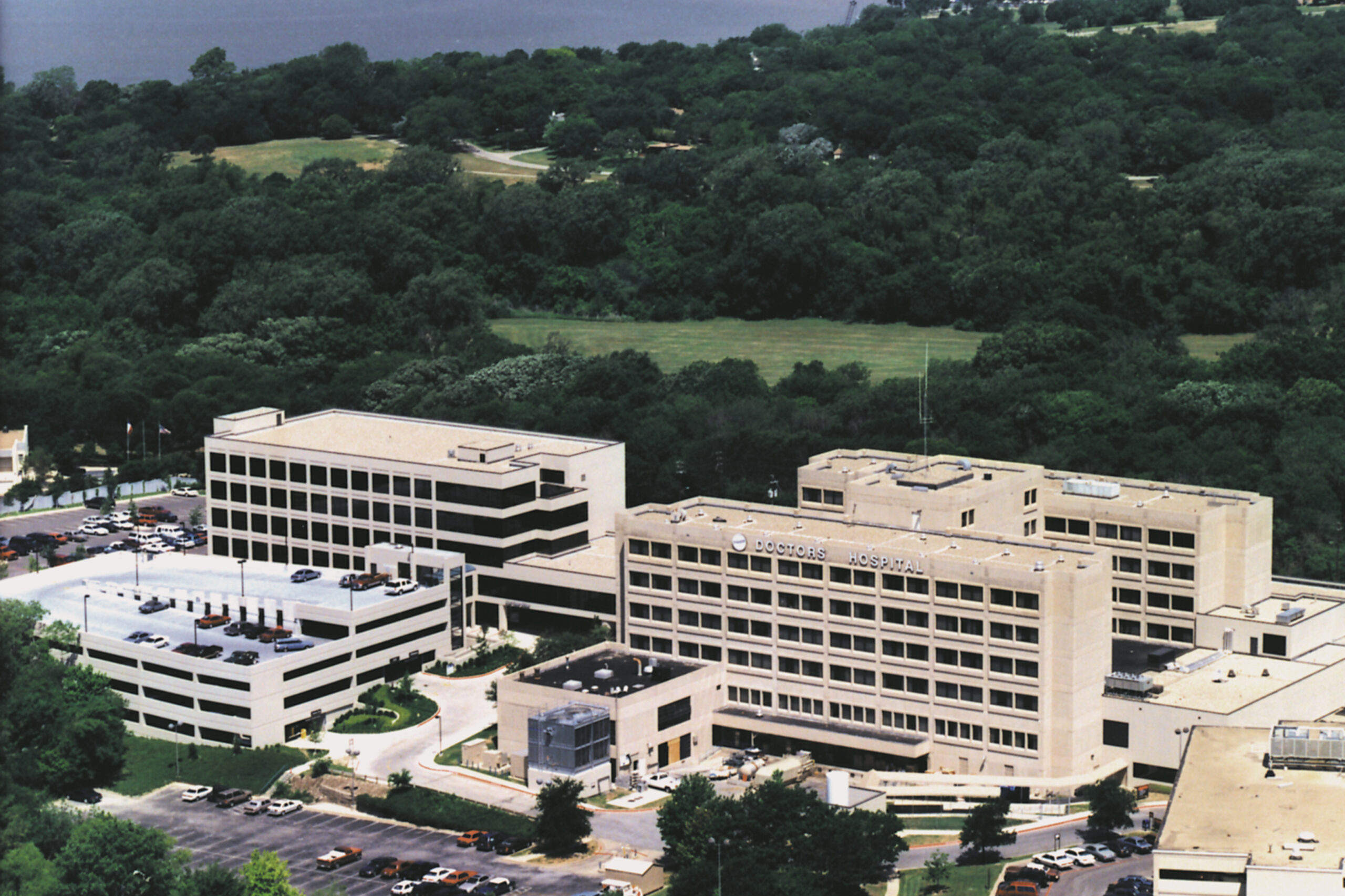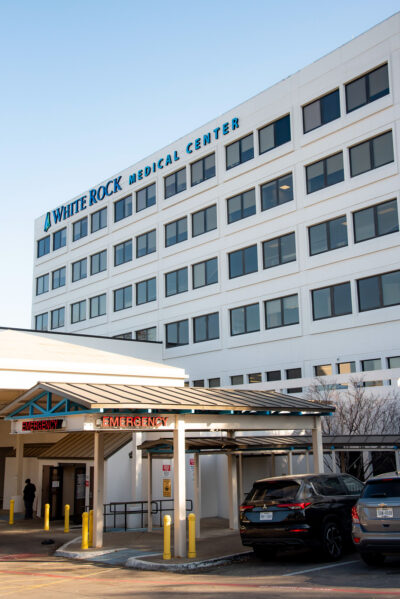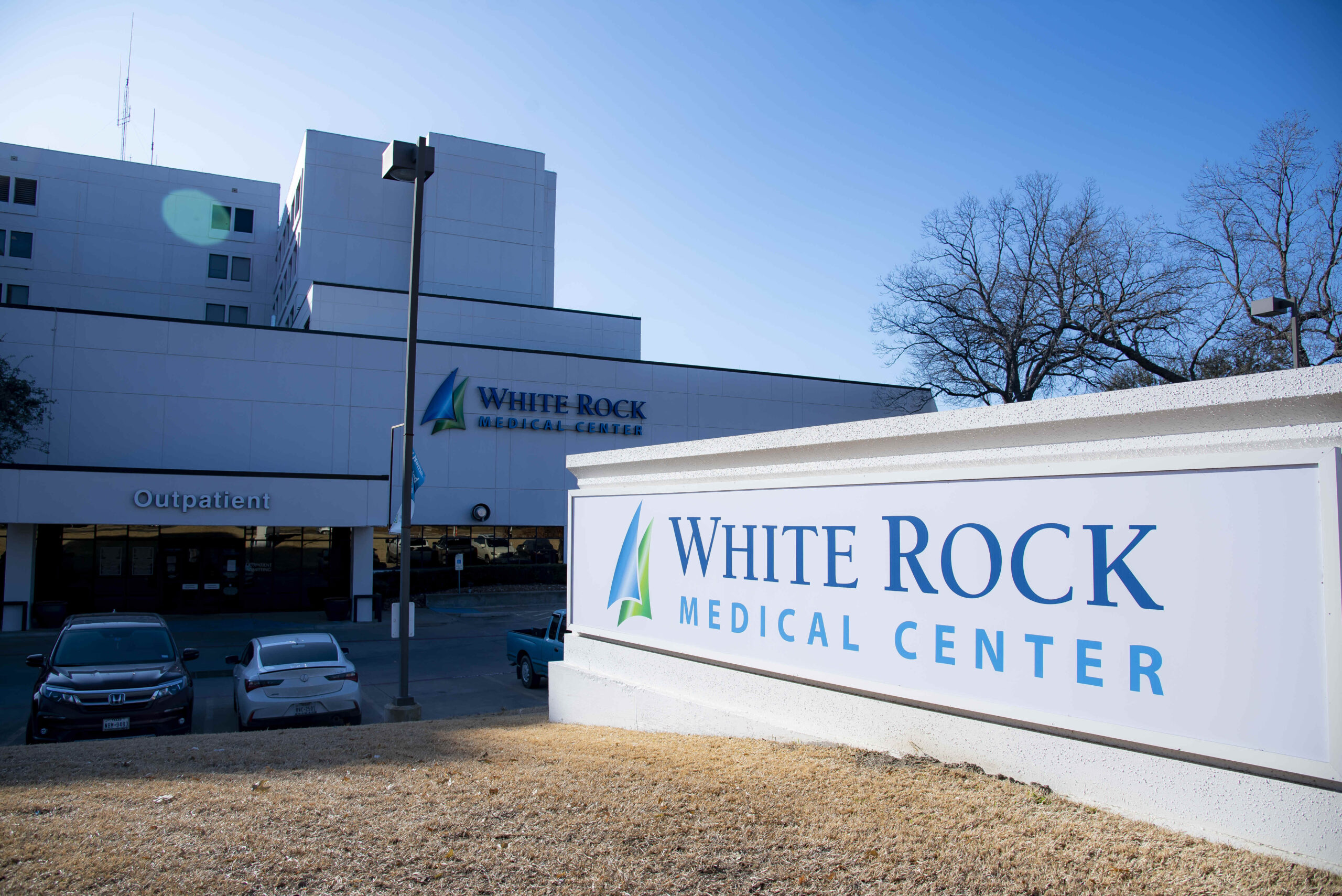
Aerial view of Doctors Hospital. Photography from Advocate archives.
“The search for a hospital to service the White Rock area is over,” reads the lead of a June 1958 story from bygone weekly newspaper The White Rocker.
A 110-bed hospital would be built as an addition to the Doctor’s Medical Center on Garland Road, the president of the White Rock Chamber of Commerce announced. The cost was estimated to be $1 million. When completed, the hospital would offer medical and surgical services, outfitted with state-of-the-art equipment, a communications system, air conditioning and a parking lot to accommodate 200 vehicles.
What exists today is a 218-bed medical center near the intersection of Garland Road and North Buckner Boulevard operated by California-based Pipeline Health. Inside the ground-floor lobby, the hospital displays certificates marking its 50th anniversary, celebrated in 2009, along with a plaque representing the patent presented in 1993 to Paul J. Durfee, a cardiac catheter technician at Doctors Hospital, for the Durfee Catheter.
Many East Dallas neighbors have stories to tell about the facility now named White Rock Medical Center. More difficult to explain is how the small, independent hospital functions in a city with plentiful medical resources, including the most-awarded not-for-profit health system in Texas, the top scientific health care research institution and the No. 10 hospital system in the nation, according to U.S. News & World Report, Nature Index and The Lown Institute, respectively.
The Doctors years
Over the years, the facility has been under different ownership and names, but it began in 1959 as Doctors Hospital, a nonprofit.
It transitioned to a for-profit hospital in early 1984, when National Medical Enterprises bought it, says Gene Ward, who began working at the hospital as the director of finance in 1967. NME acquired American Medical International in 1995, and the company’s name became Tenet Healthcare.
“One of the strengths of Doctors Hospital, always a strength in my opinion, was that the original members of the medical staff, they were good doctors,” Ward says. “They were very ethical folks.”
Around 1971, the hospital began searching for a new location, Ward says. Hospital leaders decided on a nearby property, went through the rezoning process and began construction in 1975. Also around that time, Ward’s work focused on the development, and his former responsibilities were delegated to a new director of finance.
East Dallas resident Carolyn Farmer started working at the hospital in 1979 as a nurse in the emergency department. Less than two years later, she was promoted to night house supervisor, and during her 37 years at the hospital, she was also the day house supervisor and supervisor of the day surgery department.
“It felt like a family,” Farmer says. “There were a lot of us that stayed there for a very long time.”
When issues arose, it usually had to do with leaders and employees having different styles, ideas and personalities, Farmer says, but that could be said of any working environment.
Farmer has also been a patient at Doctors Hospital, where she had knee surgery and received great care, she says. Her sense of the hospital’s reputation during the time she worked there was generally favorable; she says she didn’t hear many bad reports or rumors.
But other patients describe different experiences.

White Rock Medical Center. Photography by Emil Lippe.
About 40 years ago, East Dallas resident Kathy Powers was riding her bike around White Rock Lake. She had an accident, went over the handlebars and landed on her head. A police officer took her to the hospital, but Powers says a football player with a broken pinky finger was seen before she was. She says she still has a bump on her head.
Adrianne Allen took her daughter to the hospital about 15 years ago, having trouble getting the fever to drop. There were two or three others in the waiting room, and Allen says she waited at least seven hours before her daughter was seen. Inside the patient room, she saw blood and chunks of hair, she says, but the staff declined to transfer them to another. Her daughter was eventually given some antibiotics, and they left after about 10 hours.
Lucy Fulls was a recruiter at the hospital for a year, starting in 2013, and was responsible for hiring clinical staff. At the time, Fulls had been a recruiter for about six years and accepted a job from Tenet Healthcare, not having any hospital experience. Her mother-in-law had told her about a bad experience she had while getting a knee replacement several years earlier, but Fulls trusted the positive reviews provided by company employees.
Her own experience, she says, couldn’t have been more different. She was trying to fill up to 90 positions at a time, all by herself — scheduling and conducting every interview, giving every tour. One of the roadblocks to keeping hires was compensation, and Fulls says nurses left the facility once they finished their residency.
“It is to this date the most stressful job I’ve ever had,” Fulls says.
The Baylor years
In March 2015, Baylor Scott & White and Tenet Healthcare, the owner and operator of the hospital, announced a partnership to jointly own five medical facilities in North Texas, including Doctors Hospital at White Rock Lake.
As part of the deal, the name of the East Dallas hospital changed to Baylor Scott & White Medical Center – White Rock, and Baylor took a majority ownership interest in the hospital, but Tenet continued to manage operations. Current hospital leaders remained in place, and the companies expected minimal changes for employees.
Brett Lee, the CEO of Tenet’s Dallas market, says in a 2015 news release that the partnership would better enable the hospital to care for patients.
(Baylor Scott & White Health could not be reached for comment.)
The Pipeline years
Baylor’s ownership didn’t last long. In 2018, Pipeline Health purchased the hospital, and it became City Hospital at White Rock Lake. Jane Brust, the vice president for marketing and communications at Pipeline, says the company was looking to expand beyond Los Angeles, and Baylor was looking for a buyer.
As with Doctors Hospital, patient feedback for City Hospital at White Rock Lake is mixed.
In 2018, Powers — who had been treated for a head injury there decades earlier — was taken to the hospital by ambulance, believing she was having a stroke. Powers says she was left on a gurney in the hallway for hours before undergoing any tests. She spent days at the hospital and had months of speech, physical and occupational therapy. When she resumed work as a receptionist at a veterinary hospital, a job she had for decades, she noticed her performance had declined following the stroke, she says.
But Allen, who had taken her daughter to the hospital when it was Doctors, had physical therapy there about a year ago, and she says she didn’t have any issues that time. Another patient, Megan Polakoff, says the staff took good care of her when she needed an emergency appendectomy in August 2020.
(White Rock Medical Center can’t disccuss details of a single patient experience without patient consent because of privacy laws. However, Melissa Grych, the director of marketing and communications for the hospital, says the hospital’s top priorities are always patient safety and quality care.)
Brust says market research revealed that some people found the hospital’s name confusing. Plus, when Pipeline acquired it, there wasn’t a comprehensive branding implementation plan.
To remedy this, Pipeline announced a rebranding in January 2022. The facility became White Rock Medical Center and took a new logo, and ownership launched a revamped marketing strategy to better describe its services.
“If we had been perceived as sort of asleep, we wanted to let the community know, this was a new day for White Rock Medical Center, and Pipeline was making investments in surgical robots and other things to really improve the facilities and enhance patient care,” Brust says.
Those investments went toward technologies that provide minimally invasive procedures, enabling customization to patients’ needs. The hospital also has a four-arm da Vinci system and a ROSA knee system, White Rock Medical Center CEO Matt Roberts says in a statement. These computer-assisted surgical technologies offer benefits such as a lower risk of infections and scarring and a shorter recovery time. They also allow surgeons enhanced vision, dexterity and control.
The hospital offers bariatric, cardiology, orthopedic, women’s health and emergency care services, Roberts says. Its bariatrics program is one of 11 throughout the country and the second in Texas to earn elite accreditation.
It also has an outpatient rehabilitation program that includes physical therapy, medically supervised cardiac rehab and aquatic therapy with a heated, indoor pool.

White Rock Medical Center. Photography by Emil Lippe.
White Rock Medical Center opened a primary care clinic at Mockingbird Commons, at the corner of East Mockingbird Lane and Abrams Road, in July.
In October, Pipeline announced it had filed for Chapter 11 bankruptcy protection, citing industry-wide challenges exacerbated by the COVID-19 pandemic, such as increasing labor and supply costs, delayed payments from insurance plans and decreased ability to generate revenue.
The clinic at Mockingbird Commons closed in late December, and services were moved to the main campus near White Rock Lake, Roberts says, because it was a financially prudent move to manage available resources. The two doctors who had been at the Mockingbird Commons location and specialize in family and internal medicine began caring for patients at a building on Poppy Drive right next to the hospital.
Pipeline shared news in January that the United States Bankruptcy Court for the Southern District of Texas confirmed the company’s Chapter 11 plan, which included the sale of two hospitals, evaluating vendor contracts, developing a business plan to balance the budget and forming financial agreements with stakeholders who wanted to support the company in the future.
In addition, a few of the company’s top leaders said they would be “stepping away”; their replacements were announced in February, along with news that the company was officially emerging from bankruptcy.
The local hospital is different from others nearby because it is a community-focused medical center that handles a range of health concerns and cares for patients in their neighborhood, Roberts says.
Following the company’s exit from bankruptcy, White Rock Medical Center is focused on expanding key services. It plans to grow its home-based therapy program, which takes physical, occupational and speech therapy and wound care to patients.
The hospital also expects to open a new pulmonology clinic this summer, where patients can receive care for interstitial lung disease and other abnormal findings in their lungs. People with sleep apnea could also benefit from the pulmonologists, who will work alongside the hospital’s sleep center.
And no, the hospital’s name isn’t changing, and neither is the ownership.





